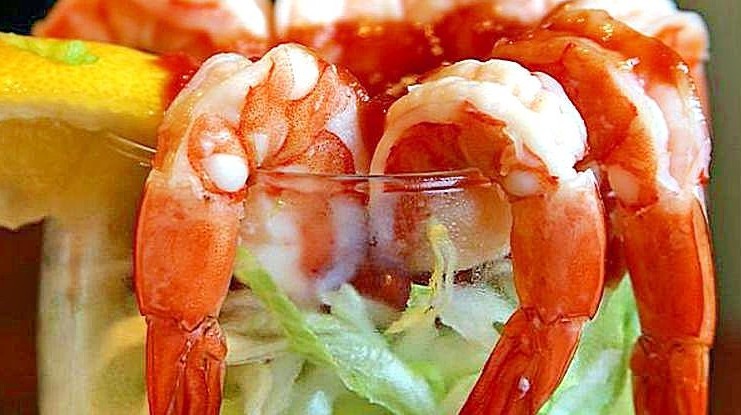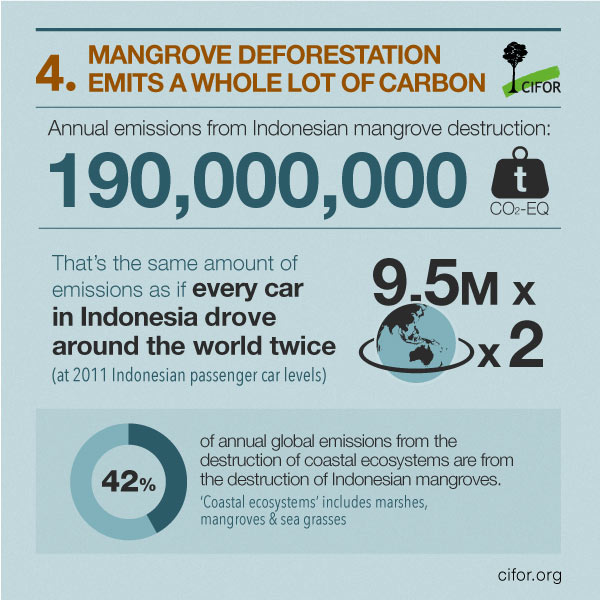
Three years ago when J. Boone Kauffman, an ecologist from Oregon State University and an associate of the Center for International Forestry Research (CIFOR), released a paper that calculated the enormous impact mangrove shrimp farming has on the environment, he decided to personalize the research.
He put the shrimps on dinner tables.
Boone estimated that a 100-gram serving of shrimp – a shrimp cocktail, say – had an ecosystem carbon footprint of 198 kilograms of CO2 if it had been produced on a typical mangrove fish farm.
That tempting appetizer held an unambiguous warning sign about habitat loss and deforestation.
“The carbon footprint of the shrimp is about 10-fold greater than the land use carbon footprint of an equivalent amount of beef produced from a pasture formed from a tropical rainforest,” he recently told an audience of scientists as CIFOR.
Shrimp was once considered sophisticated fare for the international jet set – the kind of posh nosh James Bond would eat.
Shrimp can be found everywhere now – but its ubiquity does not make it any more efficient to farm: extensive-low input system shrimp farms produce a mere one kilogram of shrimp for every 13.4 square meters of mangrove.
And that harvest only lasts so long; coastlines that are home to shrimp farms are usually abandoned after less than ten years – exhausted and contaminated, and “unusable for another 40 years,” according to Kaufmann.
LET’S GET REAL
Kauffman’s deliberate emphasis on the “real” in his research makes for the presentation of scientific data that resembles a TED talk.
“If you are four of your friends go out for dinner tonight, and you each have a shrimp cocktail appetizer, that carbon footprint would be 1,138 kilograms,” he says. “Then you each have a nice big steak. The carbon footprint of that dinner would be another 1,367. So that’s 2,498 kilograms of carbon footprint.
“That’s equivalent of burning about 281 gallons (1064 liters) of gasoline.
“Now if we were on the West Coast – say in Oregon where I live – and we drove all the way across the United States to the east coast and New York City …. well driving across the North American continent would create a lower footprint than this meal.
“Even if we were in a big pick-up truck, the carbon dioxide emissions are heavier than the weight of our big American pick-up truck”.
In the span of just a few decades this carbon may be lost to the atmosphere
By translating hard scientific data into blunt but colorful evidence about the devastating environment damage done by an enjoyable – and seemingly innocent – night out with friends – Kauffman has found that even scientists approach his findings with a more personal interest.
Boone Kauffman is currently at CIFOR in Bogor continuing his research into mangroves.
Here is a short interview with him.
The research was released in 2012 to fantastic response for a scientific research. Where have you taken your inquiries since then?
Up until 2012 we had focused only on understanding the carbon stocks of the intact mangroves. Since 2012 we have been focusing more on two aspects. One is, what are the carbon stocks of areas of mangroves that have undergone land use? This would be cattle pastures in Mexico and shrimp pond conversion here in Indonesia as well as Latin America.
This has given us quantitative data on the amounts of emissions – greenhouse gas emissions that arise from conversion of mangrove to other land uses. And this has been very surprising – the amount of emissions that come from this.
And the largest discoveries we have made is the magnitude of which we lose this soil carbon that has perhaps been sequestered and stored in mangroves for thousands of years and how in the span of just a few decades this carbon may be lost to the atmosphere.
You’ve quantified this by indicating that for thousands of years mangroves were healthy …. then we walk in and manage to destroy everything in just decades. What is the one thing you can recommend that we do, now we know this?
I think that we need to be aware of the consequences of our land uses. When you are consuming…there are certain products that we enjoy in modern society that come at a very very high carbon dioxide / greenhouse gas emission price.
People have a right to be aware of the consequences of the food they eat and that’s the role that ecologists can play - letting the public know
And farm raised shrimp and beef raised in rainforest converted to pasture have a very high cost in losses of biological diversity, water quality…..and now what we are discovering as well, in greenhouse gas emissions.
You must be used to seeing people being horrified when you present your data. Even as an ecologist, you must hope for behavior change. But does that really happen?
People have a right to be aware of the consequences of the food they eat and that’s the role that ecologists can play – letting the public know.
And what I’m here doing is explaining in a comprehensible manner – let them know that when you do eat steaks from the rainforest or shrimp from mangroves it does come at a pretty steep environmental cost. Cost and losses of biodiversity, in social justice, in greenhouse gas emissions.
Do you eat beef or shrimp?
No!
Are you hoping others feel an obligation to act?
One would hope so. I feel, philosophically we need to leave this planet in a better condition for our children and we’re not doing that. We are seeing unprecedented rates of deforestation of mangroves as well as other forests.
If indeed we want to slow climate change, there’s several contributions we can make, like reducing fossil fuels, but also reducing those land uses that are really, really causing egregious losses in bio diversity as well as greenhouse gas emissions and that’s where a lot of our research results can help the public make informed decisions on their daily purchasing or buying habits.
For information about Boone Kauffman’s research, please contact b.kauffman@cgiar.org
- Watch Boone Kauffman’s presentation here:
We want you to share Forests News content, which is licensed under Creative Commons Attribution-NonCommercial-ShareAlike 4.0 International (CC BY-NC-SA 4.0). This means you are free to redistribute our material for non-commercial purposes. All we ask is that you give Forests News appropriate credit and link to the original Forests News content, indicate if changes were made, and distribute your contributions under the same Creative Commons license. You must notify Forests News if you repost, reprint or reuse our materials by contacting forestsnews@cifor-icraf.org.
